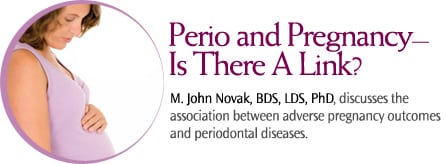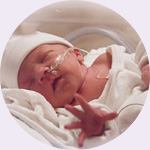
Perio and Pregnancy—Is There A Link?
M. John Novak, BDS, LDS, PhD, discusses the association between adverse pregnancy outcomes and periodontal diseases.
The views expressed in this interview are the author’s.
Q. Is there an association between adverse pregnancy outcomes and periodontal diseases?
A. Yes, enough evidence exists, mainly through cross sectional studies (which look at a whole population not only those with specific characteristics), to show there is an association between the presence of periodontitis and preterm delivery and low birthweight infants.1 However, the exact nature of that association is still unclear. In this context, it’s very important to use the term “association” rather than “connection.” The word connection means that what happens in the mouth is connected to what happens with the fetus during pregnancy. The periodontal and dental communities would like to unequivocally show that inflammation in the oral cavity is connected to the delivery of a preterm infant.
Q. Why has there been such a discrepancy among study results, with some studies showing a clear association while others fail to do so?
A. One of the problems with this research is that there is no universally accepted standard for the diagnosis of periodontal diseases. In the studies that noted an association, periodontitis is based on general pocket depth and bleeding on probing. Without a clear definition of periodontal diseases, a study subject may have one periodontally involved tooth while another has 32 affected teeth. Many of these studies differ in the way that periodontitis is defined. Some studies define the criteria of periodontitis at the beginning of the study while others do it after the study. The latter looks at women who have already had preterm delivery or low birth weight babies to see what type of periodontal diseases they have.
Q. What other factors have affected study results?
A. All diseases tend to vary by racial group, ethnicity, and socioeconomic status. For instance, diabetes is much more prevalent among people who have a low socioeconomic status because as the socioeconomic status improves so does the diet, exercise routine, access to health care, etc. The incidence of diabetes decreases as people move up the socioeconomic scale. This relationship is the same with pregnancy outcomes. Many of the studies done in the United States on the association between low birth weight/preterm birth and periodontal diseases have been conducted on people of low socioeconomic status. They tend to have not only poor oral hygiene but also unhealthy lifestyles in relation to diet, smoking, and exercise. Variation exists also by race. Preterm delivery is much more prevalent among African American women—about 18% deliver preterm.7 Among Caucasian and Latino pregnant women, between 10% and 14% deliver preterm.7 In Europe, the majority of people have access to health care, thus, the studies conducted there tend not to show a distinct association between periodontal diseases and preterm delivery/low birthweight.
Q. What is the nature of the association?
A. The premise is that the inflammatory molecules from the oral cavity can get into the circulatory system, eventually reaching the fetal membranes where they promote an early delivery. The delivery of a full-term infant is the result of inflammation, which causes the cervix to widen and dilate and the membranes to dissolve. This inflammation is the same that is present in periodontal diseases. The same inflammatory molecules that destroy the fetal membranes are the same molecules that destroy gum tissue. The dental profession, beginning with the early work of Steven Offenbacher, DDS, PhD, MMSc, from the University of North Carolina, has tried to show that infection from the oral cavity moves to the fetal membranes—infecting both the fetus and fetal membranes, causing more inflammation, and resulting in the premature delivery of the child. There is some precedent for this idea of infections from other locations reaching the fetus. What’s more, bacteria from the oral cavity has been found in the fetal membranes.
To show connectivity from the dental point of view, evidence must demonstrate that if the periodontitis is treated, there is a reduced risk of delivering a preterm infant. The National Institutes of Health found this concept important and funded two large studies on the topic. Neither of the studies showed that the treatment of periodontitis had any effect on the rates of preterm delivery.8,9
Q. What were the main factors in these studies that led to the negative findings?
A. The Obstetrics and Periodontal Therapy Trial (OPT) study and the Maternal Oral Therapy to Reduce Obstetric Risk (MOTOR) study both showed that efforts to eradicate periodontitis were unsuccessful.8,9 The periodontitis was treated with scaling and root planing but none of the studies actually eliminated the disease. The other problem is that both studies were conducted on the general population. In the general population, one in 10 pregnant women will deliver a preterm infant.7 So when conducting a study within the general population, only 10 of 100 study participants will even have a chance of being affected by the treatment, and then only five of those 10 receive the treatment. The fact that neither study treated an at-risk population affected the results.
Another problem was in the study design. In both studies each patient received four scaling and root planing appointments. Some patients were healthy after two appointments while others needed additional treatment. The end of therapy was never defined.
Q. Bottom line, what do these results mean for dental professionals and pregnant women?
A. This research may be demonstrating that the association is actually a predictor of risk relative to patients’ lifestyles. Providing dental care is still important because we are educating patients about how to change their lifestyles. When dental care is provided to pregnant woman, it should also be linked to their overall health. Dental professionals should be encouraging pregnant women to live healthy lifestyles—to not smoke, to get regular exercise, and to not gain too much weight during their pregnancies. Research is showing that if women stay at a healthy weight and live a healthy lifestyle, their babies are likely to be healthy too.10 The presence of periodontitis may be a very good risk predictor relative to lifestyle, but it also could be a risk predictor of the biology occurring in the body. Periodontitis is an inflammatory disease and inflammation is related to many systemic health problems, such as cardiovascular disease, dementia, Alzheimer’s disease, and diabetes. We know that if the body’s inflammatory response is not quite right it can significantly impact different organs. So the presence of periodontitis may tell us that something is not right in the body.
Q. Why is it important to establish this association between preterm delivery/low birthweight and periodontal diseases?
A. I think it’s very important for the dental profession to promote oral health during pregnancy because we need to support healthy lifestyles. The evidence that there is an association between periodontitis and adverse pregnancy outcomes is enough for the profession to discuss with patients. Clinicians can advise their patients: “Although we don’t fully understand the association, the mouth is a source of infection so let’s work together to control the infection in your mouth.”
This discussion needn’t happen only in the dental office. The medical profession needs to be educated about this association so they can advise their pregnant patients. However, many nurse practitioners and obstetric nurses lament that most oral health problems they see are in patients who rely on Medicaid—and dentists don’t see these patients. The United States does not currently have a system to really help at-risk populations.
Research on pregnant women and oral health is ongoing. The University of Kentucky currently has a study underway on gestational diabetes, periodontal diseases, and adverse pregnancy outcomes. The study will be completed at the end of next year.
A CLOSER LOOK AT PRETERM BIRTH.
 The process of premature birth is complex. In almost 40% of preterm births (before 37 weeks gestation), the cause is not known.2 There are many factors that contribute to why some babies are born prematurely, from poor health habits in mothers (eg, smoking, obesity), to serious risks to the mother’s health, such as preeclampsia and diabetes. Women who have delivered one child pre maturely are at a much higher risk of delivering another preterm infant. The incidence of preterm birth is also higher among African-American women, women older than 35 years and younger than 17 years, and women of low socioeconomic status.2
The process of premature birth is complex. In almost 40% of preterm births (before 37 weeks gestation), the cause is not known.2 There are many factors that contribute to why some babies are born prematurely, from poor health habits in mothers (eg, smoking, obesity), to serious risks to the mother’s health, such as preeclampsia and diabetes. Women who have delivered one child pre maturely are at a much higher risk of delivering another preterm infant. The incidence of preterm birth is also higher among African-American women, women older than 35 years and younger than 17 years, and women of low socioeconomic status.2
The causes of preterm birth may not be fully understood but the costs to premature infants and their families are clear. Premature infants face long stays in the neonatal intensive care unit and significant health problems, including increased risk of cerebral palsy, mental retarda tion, learning problems, chronic lung disease, and vision and hearing problems.2 According to the Institute of Medicine of the National Academies, the cost of caring for these babies is $26 billion per year.3
There is hope. Research shows that the administration of progesterone decreases the risk of preterm birth in women who have previously delivered a premature baby.4 The use of antibiotics may also prevent preterm delivery among women who have already had a birth where the membranes ruptured prematurely and among women who have vaginal infections.5 A stitch to keep the cervix closed, a technique called cerclage, may help prevent preterm delivery among women who have a weakened cervix or other cervical abnormalities.6 For more information about how you can make a difference in preventing premature birth, visit the March of Dimes Foundation website at: www.marchofdimes.com.
REFERENCES
- Xiong X, Buekens P, Fraser WD, Beck J, Offenbacher S. Periodontal disease and adverse pregnancy outcomes: a systematic review. BJOG. 2006;113:135-143.
- March of Dimes. Fight for Preemies. Available at: http://marchofdimes.com/prematurity/?link=42698Title. Accessed September 29, 2010.
- Institute of Medicine (US) Committee on Understanding Premature Birth and Assuring Healthy Outcomes. Preterm Birth Causes, Consequences, and Prevention. Washington, DC: National Academies Press; 2007.
- Dodd JM, Flenady V, Cincotta R, Crowther CA. Prenatal administration of progesterone for preventing preterm birth. Cochrane Database Syst Rev. 2006;1:CD004947.
- McGregor JA, French JI, Parker R, et al. Prevention of premature birth by screening and treatment for common genital tract infections: results of a prospective controlled evaluation. Am J Obstet Gynecol. 1995;173:157-167.
- Jorgensen AL, Alfirevic Z, Tudur Smith C, Williamson PR; cerclage IPD Meta-analysis Group. Cervical stitch (cerclage) for preventing pregnancy loss: individual patient data meta-analysis. BJOG. 2007;114:1460-7146.
- Heron M, Sutton PD, Xu J, Ventura SJ, Strobino DM, Guyer B. Annual summary of vital statistics: 2007. Pediatrics. 2010;125:4-15.
- Michalowicz BS, Hodges JS, DiAngelis AJ, et al. Treatment of periodontal disease and the risk of preterm birth. N Engl J Med. 2006;355:1885-1894.
- Offenbacher S, Beck JD, Jared HL, et al. Effects of periodontal therapy on rate of preterm delivery: a randomized controlled trial. Obstet Gynecol. 2009;114:551-559.
- Davies GA, Maxwell C, McLeod L, et al. Obesity in pregnancy. J Obstet Gynaecol Can. 2010;32:165-173.
From Dimensions of Dental Hygiene. October 2010; 8(10): 34, 36, 38.

